Corona 1010 for Charged Aerosol Detection
Nitrogen gas plays multiple roles of atomization, drying and collision charging in the CAD process. The higher the purity and the stability of the nitrogen, the higher the sensitivity and the lower detection limit can be achieved, ensuring the repeatability and stability of test results.
Peak Scientific’s Corona 1010 nitrogen gas generator is specially designed to supply the CAD electrospray detector, and exactly meets the flow, pressure and purity requirement of the instrument. Engineered with a compact and space-saving design, the Corona 1010 offers labs a reliable source of nitrogen gas at >98% purity and a maximum flow rate of 5L/min.
 Corona 1010 in a field application
Corona 1010 in a field application
Recently, Peak Scientific’s Corona 1010 nitrogen gas generator was tested at a Thermo Fisher Technology Training Center. The results show that the measured sample baseline stability is constant, without any background interference, and high instrument sensitivity with good reproducibility of the test sample.
Instruments and methods:
|
Project |
CAD baseline testing for repeatability |
|
Instrument model |
System: Thermo Ultimate3000RS Pump:DGP-3600SD Autosampler: WPS-3000SL Column oven :TCC-3000RS Detector:Corona Veo RS Software:Chromeleon Chromatography Data System 7.2 Column :AcclaimTM 120 C18(150 ´ 4.6mm,5μm) |
|
Method |
Mobile phase A: Methanol ,B:H2O Flow rate:0.5ml/min, Methanol / H2O :(V/V=1:1) Injection volume:5µL CAD settings: Data Collection Rate :10Hz,Evap Temperature :35℃ Time:10min |
Results:
Baseline noise
According to the principle of the CAD detector, the nitrogen gas in CAD serves two separate functions via two channels. One channel is used for gas atomization whereas in the other channel, gas flows through the charged needle to produce a charged aerosol that collides with the sample particles dried by atomization. The nitrogen passes the charge to the sample particles which then pass to the ion trap.
Unreacted nitrogen gas ions are removed by the ion trap, and the charged sample particles enter the electrometer where their charge is converted to a signal. It is therefore essential that the nitrogen gas used for CAD detection is of high and stable purity to prevent background signal interfering with analysis and lowering sensitivity.
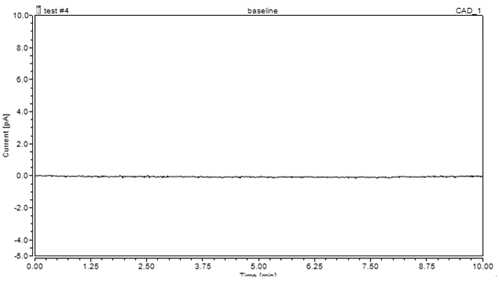 Figure 1. Baseline noise graph
Figure 1. Baseline noise graph
As can be seen on the graph, the baseline noise is stable while the background is low, indicating that the high purity of nitrogen gas produced by Corona 1010.
Nitrogen pressure signal (3 repetitions):
The nitrogen pressure is generally set according to the requirements of the instrument. The pressure should not be too high to prevent the air inlet from being flushed out and should be stable to ensure the normal operation of the instrument. The nitrogen inlet pressure set in these analyses was 56.9 psi. The Corona 1010 maximum pressure is 80 psi, which means that the generator can support the full range of analytical conditions required for various analyses.
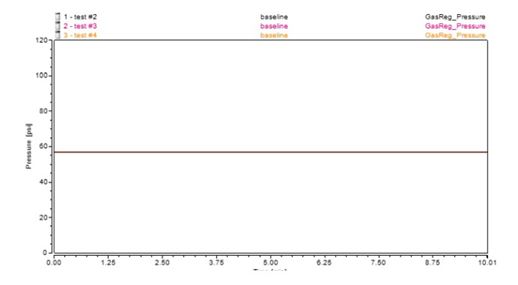 Figure 2. Nitrogen Pressure graph
Figure 2. Nitrogen Pressure graph
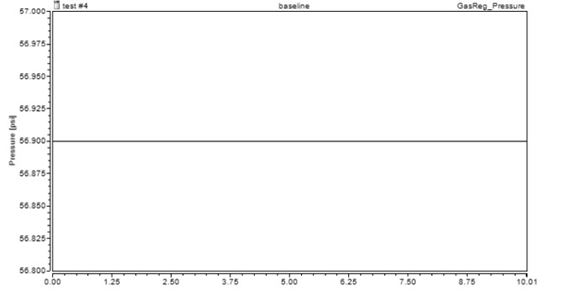 Figure 3. Enlarged view of nitrogen pressure
Figure 3. Enlarged view of nitrogen pressure
As can be seen in the experimental test results, the nitrogen gas pressure provided by the Corona 1010 nitrogen gas generator fully meets the requirements with stability, ensuring normal operation of the instrument.
Actual sample test, repeat stability
The actual test results show the spectrum and data of the continuous 6-pin test of the caffeine standard:
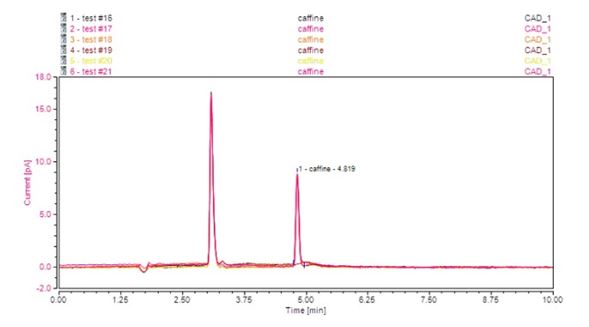 Figure 4. Test results
Figure 4. Test results
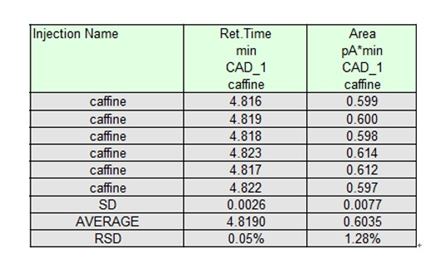 Table 1
Table 1
The results demonstrate that, under the experimental conditions of this paper, the continuous 6-pin caffeine standard has a consistent elution time, sharp peak shape, high response, no background interference and good repeatability, with a 0.05% retention time RSD. The RSD of the peak area is 1.28%, which satisfies the methodological requirements, and allows the method can be used for caffeine analysis.
*Special thanks to Thermo Fisher Technical Training Center for their great support for this test
